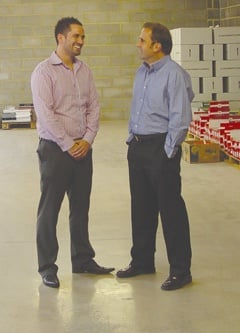On the back of the reputation of their Silestone quartz, Cosentino have introduced Sensa granite and the recycled Eco worktops. They also opened their third warehouse in the UK in the summer, where NSS visited them to find out more about their plans.
In Silestone, Spanish manufacturers Cosentino have probably the best known engineered quartz in the world. And that’s the point: they don’t so much consider they are selling a product as a brand.
To the trade, Silestone might be an engineered quartz. To the specifier and consumer, Cosentino want Silestone to be Silestone in the same way that Nylon is Nylon and to that end they put a lot of effort into getting their message out to kitchen studios and end users, as well as to fabricators.
As Christophe Gontier, Managing Director of Cosentino UK, says: “Some fabricators have a strong sales team and sometimes good marketing acumen, but not all of them. They do a fantastic job with stone and quartz but not always with the marketing, so we help them get the orders.”
Cosentino supply on a two tier basis. They have 65 ‘approved’ fabricators, who they offer training and work closely with on promotions, and another 50 fabricators who they supply on a more casual basis. Even these, though, are vetted because Cosentino insist on protecting their brand – and a bad fabrication or installation will reflect badly on the brand.
Cosentino UK now have three warehouses in the UK, having opened the third in Gloucester in the summer at a cost of £2million. It would be within their philosophy to open one in Ireland, but for now sales there are dealt with from the UK by Gavin Shaw, who has opened the three warehouses in the UK and is currently in charge at Gloucester.
There is a general manager in charge of each of the warehouses, four sales managers whose job it is is to deal with architects, housebuilders and other specifiers, and 12 promoters who visit kitchen studios to push the brand.
Between them, they pass on an average of about 10 sales a week to each of their processors.
Cosentino’s level of involvement in sales of their products was expanded by Christophe Gontier when he took over responsibility for the business in the UK, Ireland and France in 2007. He says it paid off, with sales in the first two years increasing phenomenally.
Even this year sales have increased by 25%. “It was a tough two or three months at the start of the year,” Christophe told NSS. He says he attributes the success to three excellent general managers and the sales team. “If you put 12 people on the road making eight visits a day and multiply that by 24 months you have an impact that goes straight through to our fabricators. We are also doing more and more advertising.”
The advertising is concentrating on the consumer and retailers in magazines such as Hello and kitchen magazines. This is the audience Cosentino want to reach now because they feel they are well known among fabricators. “If a fabricator tells me he doesn’t know Cosentino I won’t believe him,” says Christophe.
To help present the right image, celebrities are employed. The Silestone advertising this year has featured Amanda Lamb, presenter of the TV programme A Place in the Sun, who chose pure white Blanco Zeus for her own new kitchen in an Edwardian property in southwest London that she has refurbished.
And two-time Formula One world champion Fernando Alonso was on hand with Italian chef Simone Rugiati for the launch of the Silestone sink range, called ‘One’, in Milan this year. Silestone sponsor Fernando so that the Silestone logo is displayed on Alonso’s racing helmet as well as the caps of the Renault team.
Alonzo was also involved in the launch of the Silestone Platinum series, which is a metalic-looking range of four colours, created by curing at higher temperatures than for the regular Silestone.
For kitchen studios, Cosentino have a range of poiint-of-sale material and run promotions such as giving away Marks & Spencer vouchers for every 3.5m2 of Silestone sold. There are also exceptionally good quality merchandisers for showrooms, and when it comes to specifiers they do not just receive samples, they receive samples displayed in a presentation folder (like the one pictured on the previous page and the one being held by Gavin Shaw above).
On the back of the Silestone brand, with its USP (unique selling point) of Microban antibacterial protection and a 10-year guarantee, Cosentino have this year also introduced Sensa granite to the UK. It is made in Brazil at a rate currently of 234,000m2 a year. It’s USP is that it is pre-treated in the factory to protect it against staining and, again, it carries a 10-year warranty.
For the environmentally sensitive, a recycled quartz product called Eco was launched in the UK last month (October). Made from broken glass from mirrors, light bulbs, windows and bottles, porcelain from china, tiles, sinks, toilets and decorative elements, and crystallised ashes from industrial furnaces are mixed with stone scrap from quarries and fabrication, crushed to a powder and bonded together with a resin made from 22% corn oil.
Cosentino also offer the Scalea range of natural stone, marble and granite so their processors do not have to go elsewhere for their natural stone products – because, like any fabricator, Cosentino’s customers do not only use Silestone. And Cosentino were, after all, a stone company before they became a quartz manufacturer, even though sales of quartz have far outstripped sales of stone – their 11 Silestone production lines in Spain produce 5million square metres of the quartz a year.
Completing the picture, Cosentino also supply a range of consumables, such as silicone and mastics in 65 antibacterial colours to match the Silestone ranges and a sealer called Senguard so that the machined edges of Sensa worktops can be given the same protection as the factory-treated tops.

